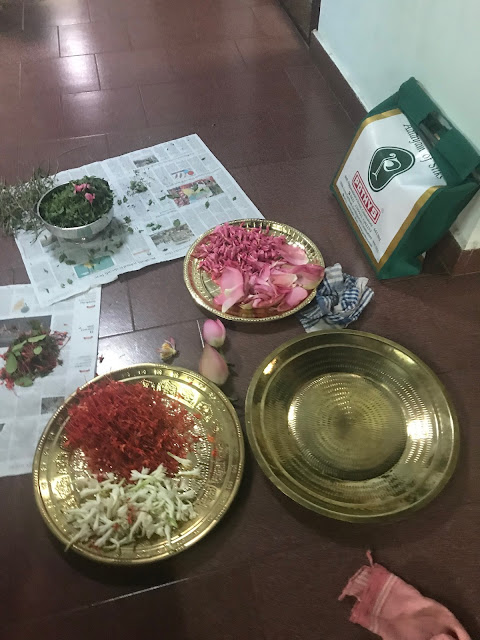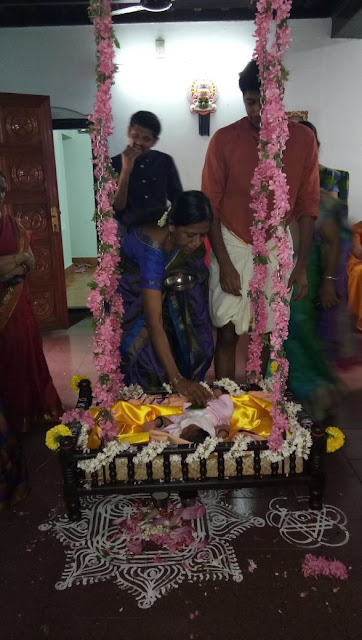Naming ceremony / Namakarnam and Jathakarma of a new born

Documentation of the ceremony held to name my niece on 22-02-2018.
Thus Deepu has delivered.
Remember her Seemantham? And remember we had done a old-time scan to know the gender of the baby?
We had tied a cloth around her waist and placed appam and kozhakkattai in it. My daughter was delegated to pick one without looking.
If my daughter was to pick 'kozhakkattai" it was a male child, otherwise a female.....
It had been an appam! And indeed it is a girl!! :D
Meet my pretty niece....
Is she practising to be the next "Priya Warrier" - the famous wink girl! 🤣
Nah! She is saying she loves her Athai (me)!
She was born on January 25, on her grandfather's birthday.
While her birth had been natural, she had developed some complications as her Vitamin D was down. Her mother had not received ample sun light in North Carolina, USA because of the cold climate and thus the baby did not have it in sufficient quantity too.
Thus her Jatha karma, naming ceremony and തൊട്ടിൽ ഇടൽ /placing her in a traditional hammock, had to be postponed to her 28th day of birth.
It is said that in the olden times; Jathakarma used to be done even before the umbilical cord was cut; as it was considered as 'shuddham'!
Jathakarma is done to remove any deficiencies caused to the baby by the womb (garba) or seed (bheeja).
When I reached Deepika's (the new mother's) home this morning, these were the sights that welcomed me.
And inside the house, the pooja preparations were going on.
While the rest of the arrangements seemed usual, the presence of a decorated 'മുറം" usually used for sieving the husk from the grain and presence of a tray with honey, curd, ghee, sugar and whole rice grain with husk was intriguing.
Post breakfast and meeting my niece, my work as her father's sister (aka Athai) started.
We have to first fake the bath of the baby, so that the rakshasas and the bad other-worldly beings are fooled!!
Time to give the അമ്മി കുഴവി(stone grinder) which will be our 'mock baby' a bath.
How does my (mock) baby look???
Poor baby must be hungry, let's give it some milk....
Sleep baby!!
The original was fast asleep! She too got a "काला टीका". We do not want any evil eyes on her for sure!
Now that the bad ones have been hoodwinked....we will make the 'real' baby wear ornaments for the first time. And again Athai (that is I) get to do the honours!!
We start with bangles made of neem stem. Black bangles are a must; as is a black thread for her waist. Then gold on her hands, neck and waist. On her leg - silver and a special "മുപ്പിരി കാപ്പ് " made of trimetal are put.
While most are what are gifted by both the sets of grandparents, some are given by the other uncles and aunts.
This is the present sent in by her father's brother and wife (Ravi & Vidya) from Dubai. It has a cute 'Mahalakshmi' locket.
A short prayer to the God's to give her all prosperity...
Let's start....
She is not really enjoying this!
She is wearing silver and the tri-metal anklets...
All this function usually gets done with the 'singers' belting out auspicious classical music. But on this occasion, I seemed to be the only singer and I sounded like a broken record singing the only song I know - Seetha Kalyana. Something is better than nothing, I suppose.
Once I passed on the 'decorated baby' to the mother; she did the wise thing and removed most of the gold; while leaving some on.
Now it was time for the priestly functions to start and the baby's dad (my cousin brother) started off by taking the blessings of elders.
The following rituals are done to help the baby get purified - by prayer and fire - for the mind, body and soul.
The baby's body should be healthy, no disease should affect it and even if something does affect ; the body must be able to retaliate.
Mind should reach it's full potential.
Soul must not forget it's purpose (with the help of the 'pitr' / forefathers).
He starts by wearing the ദർഭ ring around his ring finger.
The water has to be sanctified with prayers.
The mother joins her husband.
Cleansing of the surroundings with holy water.
Time to change his 'yagnopaveetham'.
Old poonal gets discarded...
Prayers to Ganesha - remover of obstacles...
Grandmother holds the little one; who will soon take her name!
The baby is placed on the grain chaffer / മുറം...
before being placed on her father's lap...
The priest asked the dad to smell the soft spot on her head - utchi mondu parkarathu!!
And after chanting mantras invoking Medha Devi (the Goddess of Intellect); the father gives the baby honey mixed with ghee with his gold ring, thrice.
This is part of the Bala griha peeda pariharam.
Honey is great for providing relief to Kapha / mucuous. Ghee is for 'agni bhalam'. But these two cannot be mixed in equal quantity according to Ayurveda. So there is more of honey and very less ghee. And gold increases the mental prowess. Thus these three are used together. This is great for the growth of the child.
Next is a mixture of curd mixed with ghee. This is for 'pushti' / health.
They pray that the baby has health like a 'asma / stone / shila' which does not get affected by outside forces and like an 'axe / parashur' on the inside which can work against any infection.
She liked this too.
After these 2 new tastes were introduced to her, the mother is asked to feed the baby facing east, from her right breast; as the right one is supposed to be more heavy in milk and charged with more powers.
While the baby was getting fed, the father continues his prayers mostly to the Pitr - forefathers.
He gives everyone present some money, bananas, sugar and whole rice grain. The Rice grains / nellu / നെല്ല് is to be collected in the receiver's cloth. All these together is called ' Vara Dhaanam" / വര ദാനം.
Some call this 'Bheeja dhaanam". Bheejam means fertile seed. And since Rice is staple for all, the giving away of not rice, but a fertile seed which will propagate more rice, is a great Daanam / ദാനം.
On seeking explanation for this, the Vadhyar / priest explained that each birth star / നക്ഷത്ര has it's own set of good and bad. And in the olden days, when a child is born, all the people used to be given a പറ or ഇടങ്ങഴി of നെല്ല്, sugar, money and bunches of bananas. This was a way of sharing happiness while announcing the arrival of the baby and a way of warding evil.
The vadhyar further explained that in the olden days since births used to happen in-house, once a baby is born; the father would go the pond / river near the house and jump in. Yes, JUMP in. This would make the water splash and the പിതൃ or long dead forefathers would thus know the arrival of a new member to the family and their thirst would be quenched. And they will get happy that the next generation which will help them move to the next level has been born.
You can hear a lovely explanation of the Jathakarma rituals from Dr.K.V. Seshadrinatha Shastri for more.
Anyway, the baby arrived fed and it was time to name her.
Her temple name would be grandmother's (her father's mother's name) - Seetha Lakshmy.
The father calls this name in her right ear - thrice. Thus the child get's a name and gets tied to the world.
Next the mother....
Grandfather....
The name sake calls her own name in the ear of her grand daughter!
Mother's father....
Ammamma - mother's mother.
Mama - Mother's brother...
Followed by the rest of the house hold.
After this, the function winds down pretty fast.
The father and mother of the baby get the blessings of the elders...
And both the baby's mama and athai are suitably remunerated for their services rendered!! I have been promised more in the anvil! :D
A child's athai and mama hold important position in the child's life and are part of every function organised. We both represent the child's mother's side and father's side. The position of 'athai' is something I hold with great pride for all my 4 nephews and 7 nieces.
Aarathy to end the function and remove all evil eyes on the father, mother and baby.
The priests are thanked and offered dakshina...
The elders shower akshadai (turmeric stained rice) on the new parents and thus the naming ceremony of the baby ends.
Once the priest clears the place....
the decorated തൊട്ടിൽ is put up.
A bowl of milk and chundal are placed under the thottil. The milk had been removed by the time this photo was taken; just the chundal was left.
The baby is placed inside the decorated wooden swinging bed.
And all take turns to swing it.
Look at the sisters!!!
An appam is placed on her നാഭി / belly button and given to each person by the grandmother.
Look at Siva (baby's father) gobbling up the appam in the background!!
But why appam?
Appam / nei appam is a traditional sweet made with rice and jaggery and deep fried in a special mould in ghee. This sweet is round in shape and doubles in size when it gets cooked.
And according to Prasad Vadhyar of Thrissur, since the belly button is the erstwhile physical link between the mother and child, partaking this sweet by each person is a way of saying that even though many might come into the baby's life and she might partake her sweetness with others, the link between mother and child will always exist. And the sweetness of giving has been a lesson she learnt from her mother who went through the hardships of 9 months pregnancy and labour pain to give her life.
And at the very end her aarathy is taken.
Following the functions, the festive lunch / സദ്യ is served.
This is the way our 'Aadya' was welcomed into this new janma / life in our home. May God bless her with all prosperity and give her a peaceful, contended and long life.





































































































Comments
I have often heard from my Paatti about how the father must jump into the kolam and let the forefathers know about the arrival of the next in the family. I guess the same was followed even when someone in the family dies, not sure though.
Events in our lives revisited.
Mangalani bhavanthu.
cradle ceremony event organizers in india
cradle ceremony event organizers